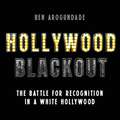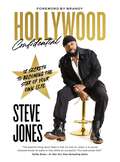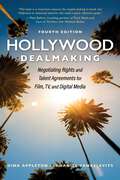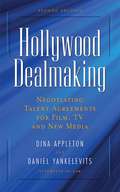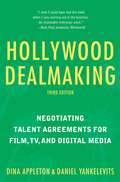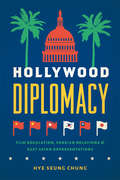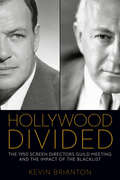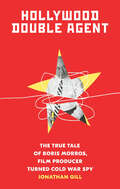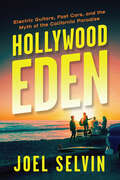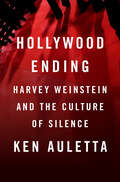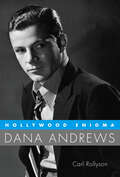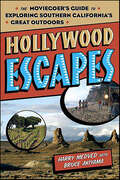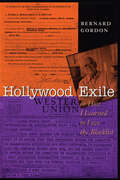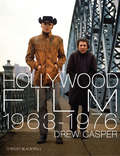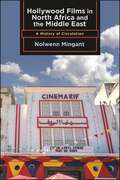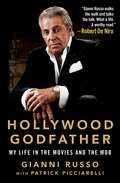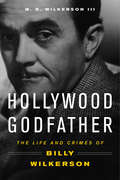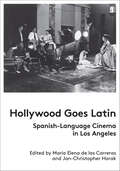- Table View
- List View
Hollywood Blackout: The battle for recognition in a white Hollywood
by Ben ArogundadeOn 29 February 1940, African American actor Hattie McDaniel became the first person of colour, and the first Black woman, to win an Academy Award. The moment marked the beginning of Hollywood's reluctant move toward diversity and inclusion. Since then, minorities and women have struggled to attain Academy Awards recognition within a system designed to discriminate against them. For the first time, Hollywood Blackout reveals the untold story of their tumultuous journey from exclusion to inclusion; from segregation to celebration. Author Ben Arogundade interweaves the experiences of Black actors and filmmakers with those of Asians, Latinos, South Asians, indigenous peoples and women. Throughout the decades their progression to the Oscars podium has been galvanized by defiant boycotts, civil rights protests and social media activism such as #OscarsSoWhite.Whether you are a film fan, history lover or diversity advocate, Hollywood Blackout is the quintessential choice for all those who wish to know the real story of Hollywood, the Oscars and the talents who fought to make change.
Hollywood Blockbusters: The Anthropology of Popular Movies
by Peter Wogan David SuttonCertain Hollywood movies are now so deeply woven into the cultural fabric that lines of their dialogue - for example, 'Make him an offer he can't refuse' - have been incorporated into everyday discourse. The films explored in this book, which include The Godfather, Jaws, The Big Lebowski, Field of Dreams and The Village, have become important cultural myths, fascinating windows into the schisms, tensions, and problems of American culture. Hollywood Blockbusters: The Anthropology of Popular Movies uses anthropology to understand why these movies have such enduring appeal in this age of fragmented audiences and ever-faster spin cycles. Exploring key anthropological issues from ritual, kinship, gift giving and totemism to literacy, stereotypes, boundaries and warfare, this fascinating book uncovers new insights into the significance of modern film classics for students of Film, Media, Anthropology and American Cultural Studies.
Hollywood Confidential: 12 Secrets to Becoming the Star of Your Own Life
by Steve JonesHow long will you wait to live your dreams? Maybe you're just starting out and are unsure where to invest your time and energy. Maybe you've started and stopped so much already that your fallback plan has become the only plan. Maybe you've simply lost touch with your creative self. In Hollywood Confidential, Steve Jones shares his twelve secrets to success accrued from working alongside some of today's most powerful voices in entertainment.Known for production successes such as Jennifer Lopez's first holiday visual and the Oprah Winfrey Network's record-breaking #1 docuseries Black Love, Steve knows the endurance and optimism it takes to pursue your passion. In Hollywood Confidential, he dishes out inspiration from his two-decade L.A. career and what he has learned from the megastars he's worked with and admired. Inside you'll find:Practical suggestions for silencing your inner critic, making the most of failures, and giving yourself permission to shineMotivating ideas to help you live out your purpose, extracted from the case studies and success stories of twelve of Hollywood&’s top actors and personalities that Steve has produced in TV/Media, or interviewed on his platform including Issa Rae, Tabitha Brown, Regina King, Angela Bassett, and moreAffirmations to keep you going as you cast a vision for who you want to becomeThought-provoking questions for reflection at the end of every chapterStrategies for anyone dreaming of moving out of the shadows, into the spotlight and leading role of their life Full of unforgettable wisdom and powerful perspective from industry leaders, Hollywood Confidential is the perfect gift for:Those who are looking to discover their purpose in lifeEveryone who has a dream to live their best, most authentic lifeThe self-made creative looking to make their mark on the worldAnyone eager to break into the entertainment or music industriesFans of Steve Jones&’s popular event series Hollywood ConfidentialReaders who enjoy anecdotes and advice from today's industry leaders It's time to take your place at the center of your life's stage. Hollywood Confidential is the jolt of encouragement you need to embrace your creative self, your biggest dreams, and your innate desire to live a fulfilled, satisfying life.
Hollywood Days with Hayes: A Novel Based on the Hit Episode Story
by Hayes GrierTwelve days and twelve nights in Hollywood with Hayes. Hayes Grier has just landed his first big Hollywood role, the lead in a big budget blockbuster film. There he meets Violet Reeves, an aspiring writer, who has also been given her first big break. If she aces her new job as Hayes's assistant on the film, which means making sure he is on time, knows his lines, and doesn't get himself killed, the director will read Violet's own screenplay. The only problem? Violet has a huge crush on Hayes. She has to keep her emotions in check, impress Hayes, and add some heart to her script. But what about Violet's heart? Does Hayes feel the same way about Violet as she does about him? Social media superstar Hayes Grier sets this story, based on the hit story on Episode (the world's largest interactive storytelling app), during the hot days and long nights of a Hollywood shoot. In addition to this novel, fans will get an exclusive, never-before-seen Q&A with Hayes, A Perfect Day with Hayes, and some family photos!
Hollywood Dealmaking: Negotiating Rights and Talent Agreements for Film, TV, and Digital Media
by Dina Appleton Daniel Yankelevits&“This book is a must-have resource for anyone looking to break into Hollywood or seasoned veterans who need a quick reference guide.&”––Matt Belloni, Puck founding partner and host of The Town The legal resources of studios and networks are legendary, often intimidating independent producers, writers, actors, directors, agents, and others as they try to navigate through the intricate maze in negotiations. This invaluable reference presents the interests of talent as well as the point of view of creative executives, producers, entertainment attorneys, agents and managers, and major guilds—making clear the role that each plays in the deal-making process. Readers will find expert insights to talent and production deals for television, feature film, major streaming platforms, and other digital media, as well as an in-depth overview of net profits and other forms of contingent compensation. Hollywood Dealmaking, Fourth Edition, also addresses changes resulting from new union agreements, and the evolution in deals as worldwide streaming platforms and FAST channels erode the past dominance of cable and linear television. In addition, this comprehensive guide includes: Basics of copyright law and impacts of recent legislation and court decisions on the deal-making landscape New section on non-writing executive producer (NWEP) deals Explanations of employment deals Details of rights acquisition Sample contracts and forms Timely new negotiating tips on the evolving landscape straight from industry insiders Deal considerations of new technologies such as generative AI Glossary of industry lingo and terminology And much more! Peppered with facts on the deals of superstar players and with summaries in each section to clarify complex legal issues, Hollywood Dealmaking is an essential resource for industry novices and veterans alike who want to sharpen their negotiation skills and successfully close each deal.
Hollywood Dealmaking: Negotiating Talent Agreements
by Dina Appleton Daniel YankelevitsHollywood Dealmaking has become the go-to resource for new and experienced entertainment attorneys, agent trainees, business affairs executives, and creative executives. Entertainment attorneys and Hollywood insiders Dina Appleton and Daniel Yankelevits explain the negotiation techniques and strategies of entertainment dealmaking and detail the interests and roles of producers, writers, actors, directors, agents, and studio employees in crafting a deal. This new edition captures the dramatic changes over the past five years in the film and television industry landscape, with two new chapters: Reality Television details the sources of revenue, syndication possibilities, and format sales of these shows as well as the talent deals that are made and the Internet/New Media chapter delves in new digital formats such as mobile phones, game consoles, video-on-demand, and web-based apps, and explains where today's revenues are generated, where the industry is headed, and talent negotiation issues. All the ins and outs of negotiating are explained, including back ends, gross and adjusted gross profits, deferments, box office bonuses, copyrights, and much more. This easy-to-follow reference is packed with expert insights on distribution, licensing, and merchandising. The book's invaluable resource section includes definitions of lingo for acquisition agreements and employment deals, twelve ready-to-use sample contracts, and a directory of entertainment attorneys in both New York and Los Angeles. In Hollywood Dealmaking, readers will recognize the key players in the process, understand the "lingo" of crafting deals, learn how to negotiate agreements for the option and purchase of books and screenplays, be able to negotiate employment deals for all members of a film or television crew, understand payment terms and bonuses, and be able to register copyrights in scripts and other literary works.
Hollywood Dealmaking: Negotiating Talent Agreements for Film, TV, and Digital Media (Third Edition)
by Dina Appleton Daniel Yankelevits"I wish I could have had this book when I was starting out in the business. An invaluable reference work." —Alan Poul, producer, Westworld The legal resources of studios and networks are legendary, often intimidating independent producers, writers, actors, directors, agents, and others as they try to navigate through the maze of legal details. This invaluable reference presents the interests of talent as well as the point of view of creative executives, producers, entertainment attorneys, agents and managers, and major guilds—making clear the role that each plays in the dealmaking process. Readers will find expert insights to talent and production deals for television, feature film, video, and the Internet, as well as an in-depth overview of net profits and other forms of contingent compensation. Hollywood Dealmaking, Third Edition, also addresses digital and new platforms, changes resulting from new union agreements, and the evolution in feature film back-end (profit participation) deals. In addition, this comprehensive guide includes: Explanations of employment deals Details of rights acquisition Basics of copyright law Sample contracts and forms Glossary of industry lingo and terminology And much more! Peppered with facts on the deals of superstar players and with summaries in each section to clarify complex legal issues, Hollywood Dealmaking, Third Edition, is an essential resource for industry novices and veterans alike who want to sharpen their negotiation skills and finalize the deals they have been seeking.
Hollywood Diplomacy: Film Regulation, Foreign Relations, and East Asian Representations
by Hye Seung ChungHollywood Diplomacy contends that, rather than simply reflect the West’s cultural fantasies of an imagined “Orient,” images of Chinese, Japanese, and Korean ethnicities have long been contested sites where the commercial interests of Hollywood studios and the political mandates of U.S. foreign policy collide, compete against one another, and often become compromised in the process. While tracing both Hollywood’s internal foreign relations protocols—from the “Open Door” policy of the silent era to the “National Feelings” provision of the Production Code—and external regulatory interventions by the Chinese government, the U.S. State Department, the Office of War Information, and the Department of Defense, Hye Seung Chung reevaluates such American classics as Shanghai Express and The Great Dictator and applies historical insights to the controversies surrounding contemporary productions including Die Another Day and The Interview. This richly detailed book redefines the concept of “creative freedom” in the context of commerce: shifting focus away from the artistic entitlement to offend foreign audiences toward the opportunity to build new, better relationships with partners around the world through diplomatic representations of race, ethnicity, and nationality.
Hollywood Divided: The 1950 Screen Directors Guild Meeting and the Impact of the Blacklist (Screen Classics)
by Kevin Brianton“Brianton’s well-documented study of a Hollywood controversy delves into one example of the post-WWII Red Scare” (Publishers Weekly).On October 22, 1950, the Screen Directors Guild (SDG) gathered for a meeting at the opulent Beverly Hills Hotel. Among the group’s leaders were some of the most powerful men in Hollywood—John Ford, Cecil B. DeMille, Joseph L. Mankiewicz, John Huston, Frank Capra, William Wyler, and Rouben Mamoulian—and the issue on the table was nothing less than a vote to dismiss Mankiewicz as the guild’s president after he opposed an anticommunist loyalty oath that could have expanded the blacklist. The dramatic events of that evening have become mythic, and the legend has overshadowed the more complex realities of this crucial moment in Hollywood history.In Hollywood Divided, Kevin Brianton explores the myths associated with the famous meeting and the real events that they often obscure. He analyzes the lead-up to that fateful summit, examining the pressure exerted by the House Un-American Activities Committee. Brianton reveals the internal politics of the SDG, its initial hostile response to the HUAC investigations, the conservative reprisal, and the influence of the oath on the guild and the film industry as a whole. Hollywood Divided also assesses the impact of the historical coverage of the meeting on the reputation of the three key players in the drama.Brianton’s study is a provocative and revealing revisionist history of the SDG’s 1950 meeting and its lasting repercussions on the film industry as well as the careers of those who participated. Hollywood Divided illuminates how both the press's and the public's penchant for the “exciting story” have perpetuated fabrications and inaccurate representations of a turning point for the film industry.Huffington Post Best Film Books of 2016Praise for Hollywood Divided“An authoritative reassessment of the meetings held by the Screen Directors Guild in 1950 to consider the adoption of a loyalty oath. Brianton traces the implications for the film industry and the reputations of key filmmakers, including Cecil DeMille and John Ford. He also offers sharp and illuminating reflections on the making of Hollywood history and myth.” —Brian Neve, author of The Many Lives of Cy Endfield: Film Noir, the Blacklist and Zulu“A breakthrough book on a topic that historians, for the most part, have considered settled. Brianton’s landmark study is fresh, thorough, and balanced, a model of Hollywood historiography. In clear prose, he takes the reader through the detailed twists and turns that created both the myth and the subsequent legend of the fateful Directors Guild Meeting that occurred during a critical time in American history.” —James D’Arc, Curator, Cecil B. DeMille Papers, Brigham Young University
Hollywood Double Agent: The True Tale of Boris Morros, Film Producer Turned Cold War Spy
by Jonathan GillThis true story of Golden Age Hollywood and Cold War espionage is a “captivating, fast-paced narrative [that] reads like a thriller” (Library Journal). Boris Morros was a major figure in the 1930s and ’40s. The head of music at Paramount, nominated for Academy Awards, he then went on to produce his own films with Laurel and Hardy, Fred Astaire, Henry Fonda, and others. But as J. Edgar Hoover would discover, these successes were a cover for one of the most incredible espionage tales in the history of the Cold War—Boris Morros also worked for Russian intelligence.Morros’s assignments took him to the White House, the Vatican, and deep behind the Iron Curtain. The high-level intel he provided the KGB included military secrets and compromising information on prominent Americans: his friends. But in 1947, Morros flipped. At the height of the McCarthy era, he played a leading role in a deadly tale. Jonathan Gill’s Hollywood Double Agent is an extraordinary story about Russian spies at the heart of American culture and politics, and one man caught in the middle of the Cold War.“Well-written and perceptive . . . Morros was an empty vessel who could be turned left or right depending on how it satisfied his personal interest.” —New York Journal of Books“Reads like an espionage thriller . . . with malevolent, powerful—and sometimes bumbling—characters.” —Kirkus Reviews“A fascinating and swift-reading biography.” —The Wall Street Journal
Hollywood Drive: What it Takes to Break in, Hang in & Make it in the Entertainment Industry
by Eve Light HonthanerHollywood Drive: What it Takes to Break in, Hang in & Make it in the Entertainment Industry is the essential guide to starting and succeeding at a career in film and TV. The completely updated second edition features new interviews with industry professionals, information about the changing social media landscape, the wide array of distribution platforms that are available to aspiring filmmakers, and much more. Honthaner's invaluable experience and advice give those attempting to enter and become successful in the entertainment industry the edge they need to stand out among the intense competition.Hollywood Drive explores the realities of the industry: various career options, effective job search strategies, how to write an effective cover letter and resume, what to expect on your first job, the significance of networking and building solid industry relationships, how a project is sold, and how a production office and set operate. You'll learn how to define your goals and make a plan to achieve them, how to survive the tough times, how to deal with big egos and bad tempers, and how to put your passion to work for you. Although no book or class can totally prepare you for a career in the entertainment industry, Hollywood Drive offers insights, direction, and a sense of confidence.
Hollywood Eden: Electric Guitars, Fast Cars, and the Myth of the California Paradise
by Joel Selvin“Hollywood Eden brings the lost humanity of the record business vividly back to life … [Selvin’s] style is blunt, unpretentious and brisk; he knows how to move things along entertainingly … Songs about surfboards and convertibles had turned quaint, but in this book, their coolness is restored.” — New York Times From surf music to hot-rod records to the sunny pop of the Beach Boys, Jan & Dean, the Byrds, and the Mama’s & the Papa’s, Hollywood Eden captures the fresh blossom of a young generation who came together in the epic spring of the 1960s to invent the myth of the California Paradise. Central to the story is a group of sun-kissed teens from the University High School class of 1959 — a class that included Jan & Dean, Nancy Sinatra, and future members of the Beach Boys — who came of age in Los Angeles at the dawn of a new golden era when anything seemed possible. These were the people who invented the idea of modern California for the rest of the world. But their own private struggles belied the paradise portrayed in their music. What began as a light-hearted frolic under sunny skies ended up crashing down to earth just a few short but action-packed years later as, one by one, each met their destinies head-on. A rock ’n’ roll opera loaded with violence, deceit, intrigue, low comedy, and high drama, Hollywood Eden tells the story of a group of young artists and musicians who bumped heads, crashed cars, and ultimately flew too close to the sun.
Hollywood Ending: Harvey Weinstein and the Culture of Silence
by Ken AulettaA vivid biography of Harvey Weinstein—how he rose to become a dominant figure in the film world, how he used that position to feed his monstrous sexual appetites, and how it all came crashing down, from the author who has covered the Hollywood and media power game for The New Yorker for three decadesTwenty years ago, Ken Auletta wrote an iconic New Yorker profile of the Hollywood mogul Harvey Weinstein, who was then at the height of his powers. The profile made waves for exposing how volatile, even violent, Weinstein was to his employees and collaborators. But there was a much darker story that was just out of reach: rumors had long swirled that Weinstein was a sexual predator. Auletta confronted Weinstein, who denied the claims. Since no one was willing to go on the record, Auletta and the magazine concluded they couldn&’t close the case. Years later, he was able to share his reporting notes and knowledge with Ronan Farrow; he cheered as Farrow, and Jodi Kantor and Megan Twohey, finally revealed the truth. Still, the story continued to nag him. The trail of assaults and cover-ups had been exposed, but the larger questions remained: What was at the root of Weinstein&’s monstrousness? How, and why, was it never checked? Why the silence? How does a man run the day-to-day operations of a company with hundreds of employees and revenues in the hundreds of millions of dollars, and at the same time live a shadow life of sexual predation without ever being caught? How much is this a story about Harvey Weinstein, and how much is this a story about Hollywood and power? In pursuit of the answers, Auletta digs into Weinstein&’s life, searching for the mysteries beneath a film career unparalleled for its extraordinary talent and creative success, which combined with a personal brutality and viciousness to leave a trail of ruined lives in its wake. Hollywood Ending is more than a prosecutor&’s litany; it is an unflinching examination of Weinstein's life and career, embedding his crimes in the context of the movie business, in his failures and the successes that led to enormous power. Film stars, Miramax employees and board members, old friends and family, and even the person who knew him best—Harvey&’s brother, Bob—all talked to Auletta at length. Weinstein himself also responded to Auletta&’s questions from prison. The result is not simply the portrait of a predator but of the power that allowed Weinstein to operate with such impunity for so many years, the spiderweb in which his victims found themselves trapped.
Hollywood Enigma: Dana Andrews (Hollywood Legends Series)
by Carl RollysonDana Andrews (1909–1992) worked with distinguished directors such as John Ford, Lewis Milestone, Otto Preminger, Fritz Lang, William Wyler, William A. Wellman, Mervyn Le Roy, Jean Renoir, and Elia Kazan. He played romantic leads alongside the great beauties of the modern screen, including Joan Crawford, Elizabeth Taylor, Greer Garson, Merle Oberon, Linda Darnell, Susan Hayward, Maureen O'Hara, and most important of all, Gene Tierney, with whom he did five films. Retrospectives of his work often elicit high praise for an underrated actor, a master of the minimalist style. His image personified the “male mask” of the 1940s in classic films such as Laura, Fallen Angel, and Where the Sidewalk Ends, in which he played the “masculine ideal of steely impassivity.” No comprehensive discussion of film noir can neglect his performances. He was an “actor's actor.”Here at last is the complete story of a great actor, his difficult struggle to overcome alcoholism while enjoying the accolades of his contemporaries, a successful term as president of the Screen Actors Guild, and the love of family and friends that never deserted him. Based on diaries, letters, home movies, and other documents, this biography explores the mystery of a poor boy from Texas who made his Hollywood dream come true even as he sought a life apart from the limelight and the backbiting of contemporaries jockeying for prizes and prestige. Called “one of nature's noblemen” by his fellow actor Norman Lloyd, Dana Andrews emerges from Hollywood Enigma as an admirable American success story, fighting his inner demons and ultimately winning.
Hollywood Escapes: The Moviegoer's Guide to Exploring Southern California's Great Outdoors
by Harry Medved Bruce Akiyama“A perfect blend of show biz lore and wanderlust . . . Hollywood Escapes allows us to re-experience, in the flesh, the great escapism that movies provide.” —Brad Schreiber, Entertainment TodayLET THE MOVIES BE YOUR GUIDE!Hike THE TREASURE OF THE SIERRA MADRE Trail!Behold the KILL BILL Chapel!Enter THE DOORS Indian Caves!Swim at BEACH BLANKET BINGO's Malibu!Escape to SOME LIKE IT HOT's Resort!Raft the STAGECOACH River!Explore HIGH PLAIN DRIFTER's Ghostly Lake!Trek to the LOST HORIZON Waterfall!Discover the STAR WARS Sand Dunes!Here is the first comprehensive guide to Southern California's outdoor filming locations taking you to more than fifty of the Golden State's most cinematic beaches, mountains, deserts, lakes, hot springs and waterfalls. Illustrated with over one hundred scenic photos and twenty easy-to-read maps, Hollywood Escapes: The Moviegoer's Guide to Exploring Southern California's Great Outdoors not only takes you to movie history's most memorable destinations, but also recommends places to dine and lodge along the way, from mountain hideaways to beach side resorts.Written by inveterate movie buffs and outdoors enthusiasts Harry Medved and Bruce Akiyama, these two native Southern Californians have interviewed dozens of actors, filmmakers, location scouts and rangers to help you explore Hollywood's most spectacular scenery.“What a neat book! . . . a guidebook to Southern California that’s equal parts history, roadmap, restaurant guide, and pop culture catalogue.” —Leonard Maltin, New York Times–bestselling author of Leonard Maltin's Movie Guide
Hollywood Exile, or How I Learned to Love the Blacklist (Texas Film and Media Studies Series)
by Bernard GordonThe Hollywood blacklist, which began in the late 1940s and ran well into the 1960s, ended or curtailed the careers of hundreds of people accused of having ties to the Communist Party. Bernard Gordon was one of them. In this highly readable memoir, he tells a engrossing insider’s story of what it was like to be blacklisted and how he and others continued to work uncredited behind the scenes, writing and producing many box office hits of the era. Gordon describes how the blacklist cut short his screenwriting career in Hollywood and forced him to work in Europe. Ironically, though, his is a success story that includes the films El Cid, 55 Days at Peking, The Thin Red Line, Krakatoa East of Java, Day of the Triffids, Earth vs. the Flying Saucers, Horror Express, and many others. He recounts the making of many movies for which he was the writer and/or producer, with wonderful anecdotes about stars such as Charlton Heston, David Niven, Sophia Loren, Ava Gardner, and James Mason; directors Nicholas Ray, Frank Capra, and Anthony Mann; and the producer–studio head team of Philip Yordan and Samuel Bronston.
Hollywood Exile: Or How I Learned to Love the Blacklist (Texas Film and Media Studies Series)
by Bernard GordonThe Hollywood blacklist, which began in the late 1940s and ran well into the 1960s, ended or curtailed the careers of hundreds of people accused of having ties to the Communist Party. Bernard Gordon was one of them. In this highly readable memoir, he tells a engrossing insider's story of what it was like to be blacklisted and how he and others continued to work un-credited behind the scenes, writing and producing many box office hits of the era. Gordon describes how the blacklist cut short his screenwriting career in Hollywood and forced him to work in Europe. Ironically, though, his is a success story that includes the filmsEl Cid, 55 Days at Peking, The Thin Red Line, Krakatoa East of Java, Day of the Triffids, Earth vs. the Flying Saucers, Horror Express, and many others. He recounts the making of many movies for which he was the writer and/or producer, with wonderful anecdotes about stars such as Charlton Heston, David Niven, Sophia Loren, Ava Gardner, and James Mason; directors Nicholas Ray, Frank Capra, and Anthony Mann; and the producer-studio head team of Philip Yordan and Samuel Bronston. In 1997, the Writers Guild of America began publicly re-crediting screenplays to their blacklisted authors. Bernard Gordon's name has appeared more often than any other. Now retired after a thirty-year career, he lives in Los Angeles.
Hollywood Fantasies of Miscegenation: Spectacular Narratives of Gender and Race
by Susan CourtneyHollywood Fantasies of Miscegenation analyzes white fantasies of interracial desire in the history of popular American film. From the first interracial screen kiss of 1903, through the Production Code's nearly thirty-year ban on depictions of "miscegenation," to the contemplation of mixed marriage in Guess Who's Coming to Dinner (1967), this book demonstrates a long, popular, yet underexamined record of cultural fantasy at the movies. With ambitious new readings of well-known films like D.W. Griffith's 1915 epic The Birth of a Nation and of key forgotten films and censorship documents, Susan Courtney argues that dominant fantasies of miscegenation have had a profound impact on the form and content of American cinema. What does it mean, Courtney asks, that the image of the black rapist became a virtual cliché, while the sexual exploitation of black women by white men under slavery was perpetually repressed? What has this popular film legacy invited spectators to remember and forget? How has it shaped our conceptions of, and relationships to, race and gender? Richly illustrated with more than 140 images, Hollywood Fantasies of Miscegenation carefully attends to cinematic detail, revising theories of identity and spectatorship as it expands critical histories of race, sex, and film. Courtney's new research on the Production Code's miscegenation clause also makes an important contribution, inviting us to consider how that clause was routinely interpreted and applied, and with what effects.
Hollywood Film 1963-1976: Years of Revolution and Reaction
by Drew CasperHollywood 1963-1976 chronicles the upheaval and innovation that took place in the American film industry during an era of pervasive cultural tumult. Exploring the many ideologies embraced by an increasingly diverse Hollywood, Casper offers a comprehensive canon, covering the period's classics as well as its brilliant but overlooked masterpieces. A broad overview and analysis of one of American film's most important and innovative periods Offers a new, more expansive take on the accepted canon of the era Includes films expressing ideologies contrary to the misremembered leftist slant Explores and fully contextualizes the dominant genres of the 60s and 70s
Hollywood Films in North Africa and the Middle East: A History of Circulation (SUNY series, Horizons of Cinema)
by Nolwenn MingantDrawing on a broad range of primary sources, from trade and government publications to interviews, Hollywood Films in North Africa and the Middle East traces the circulation of Hollywood films across the region from the early twentieth century to the present. Originally introduced by French distributors, Hollywood films have been a key component of film culture in North Africa and the Middle East. These films became a favored mode of entertainment during the first half of the century as the major US film studios built a strong distribution structure. After World War II, the changing geopolitical context of decolonization pushed US distributors out of the market. Hollywood films, however, have continued to be favored by audiences. Today, in a landscape that also includes Egyptian and Indian films, Hollywood remains a relevant force in the region’s film culture, experienced by audiences in myriad ways from the pirate markets of North Africa to state-of-the-art theatres in the United Arab Emirates.
Hollywood Frame by Frame: Behind the Scenes: Cinema's Unseen Contact Sheets
by Karina LongworthThis is your illustrated invitation to the moments when movie history was made. Photographers' contact sheets are the permanent record of every shot that they took - and through Hollywood's golden age, there was often a photographer on set, capturing the scene as actors and directors collaborated to produce classic movies. This book collects the contact sheets from classic movies like The African Queen (1951), Some Like it Hot (1959), Taxi Driver (1976), Grosse Point Blank (1997) and many more. Capturing legends such as Woody Allen, Audrey Hepburn, Alfred Hitchcock, Marilyn Monroe, and Frank Sinatra at work and at repose, these images offer rare glimpses into the art of moviemaking, the science of movie marketing, and the nature of stardom.
Hollywood Genres: Formulas, Filmmaking and the Studio System
by Thomas SchatzHollywood Genres is divided into two parts. Part I is primarily theoretical, concerned in general terms with the essential characteristics and the cultural role of genre filmmaking. This section does not examine any individual genres or genre films, but looks at the very concept of what might be termed "genre-ness". Part II is composed of six chapters, each of which examines a dominant Hollywood genre: the Western, gangster, hardboiled detective, screwball comedy, musical, and family melodrama.
Hollywood Godfather: My Life in the Movies and the Mob
by Patrick Picciarelli Gianni RussoHollywood Godfather is Gianni Russo's over-the-top memoir of a real-life mobster-turned-actor who helped make The Godfather a reality, and his story of life on the edge between danger and glamour. Gianni Russo was a handsome 25-year-old mobster with no acting experience when he walked onto the set of The Godfather and entered Hollywood history. He played Carlo Rizzi, the husband of Connie Corleone, who set her brother Sonny—played by James Caan—up for a hit. Russo didn't have to act—he knew the mob inside and out: from his childhood in Little Italy, where Mafia legend Frank Costello took him under his wing, to acting as a messenger for New Orleans mob boss Carlos Marcello during the Kennedy assassination, to having to go on the lam after shooting and killing a member of the Colombian drug cartel in his Vegas club. Along the way, Russo befriended Frank Sinatra, who became his son's godfather, and Marlon Brando, who mentored his career as an actor after trying to get Francis Ford Coppola to fire him from The Godfather. Russo had passionate affairs with Marilyn Monroe, Liza Minelli, and scores of other celebrities. He went on to become a producer and starred in The Godfather: Parts I and II, Seabiscuit, Any Given Sunday and Rush Hour 2, among many other films.Hollywood Godfather is a no-holds-barred account of a life filled with violence, glamour, sex—and fun.
Hollywood Godfather: The Life and Crimes of Billy Wilkerson
by W. R. WilkersonThis is the definitive biography of the most powerful man in Hollywood during the 1930s, '40s and '50s, the man who founded the Hollywood Reporter and the most storied nightspots of the Sunset Strip, introduced Clark Gable and Lana Turner to the world, invented Las Vegas, brought the Mafia to Hollywood, engineered the shakedown of Hollywood studios by Willie Bioff and his mob-run unions, was possibly involved in the murder of Bugsy Siegel, started the Hollywood blacklist, and helped destroy the studio system. Perhaps nobody in Hollywood history has ever ruined so many careers and done so much damage to the industry as Billy Wilkerson. Yet there has never been a solid biography of the man. Billy's son, William R. Wilkerson III, has done tremendous research on his father, interviewing over decades everyone who knew him best, and portrays him beautifully (and damningly) in this book.
Hollywood Goes Latin: Spanish-Language Cinema in Los Angeles
by María Elena de las Carreras and Jan-Christopher HorakIn the 1920s, Los Angeles enjoyed a buoyant homegrown Spanish-language culture comprised of local and itinerant stock companies that produced zarzuelas, stage plays, and variety acts. After the introduction of sound films, Spanish-language cinema thrived in the city's downtown theatres, screening throughout the 1930s, 1940s, and 1950s in venues such as the Teatro Eléctrico, the California, the Roosevelt, the Mason, the Azteca, the Million Dollar, and the Mayan Theater, among others. With the emergence and growth of Mexican and Argentine sound cinema in the early to mid-1930s, downtown Los Angeles quickly became the undisputed capital of Latin American cinema culture in the United States. Meanwhile, the advent of talkies resulted in the Hollywood studios hiring local and international talent from Latin America and Spain for the production of films in Spanish. Parallel with these productions, a series of Spanish-language films were financed by independent producers. As a result, Los Angeles can be viewed as the most important hub in the United States for the production, distribution, and exhibition of films made in Spanish for Latin American audiences. In April 2017, the International Federation of Film Archives organized a symposium, "Hollywood Goes Latin: Spanish-Language Cinema in Los Angeles," which brought together scholars and film archivists from all of Latin America, Spain, and the United States to discuss the many issues surrounding the creation of Hollywood's "Cine Hispano." The papers presented in this two-day symposium are collected and revised here.This is a joint publication of FIAF and UCLA Film & Television Archive.
